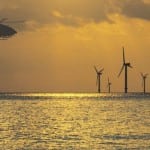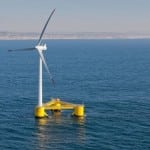The Department of Energy (DOE) has pulled back funding for two proposed offshore wind demonstration projects spearheaded separately by Dominion Virginia Power and Principle Power, bolstering its support instead for projects it says demonstrate more progress or potential.
The funding decision stems from the agency’s 2012 selection of seven offshore demonstration projects, which initially received $4 million each to complete preliminary engineering, design, site evaluation, and planning phases.
In mid-2014, the DOE culled that list, selecting only three projects to proceed to the second phase of its advanced technology demonstration initiative: Fishermen’s Atlantic City Windfarm, Principle Power’s WindFloat Pacific project, and Dominion Virginia Power’s Virginia Beach project.
As it announced the second-phase projects in mid-2014, the DOE also identified two projects that could enter the demonstration initiative, if funding became available: Lake Erie Energy Development Corp.’s (LEEDCo’s) 20-MW proposed freshwater offshore wind farm in the Great Lakes, and the University of Maine’s Aqua Ventus I project off the coast of Castine, Maine. Both projects then got an additional $3 million in DOE funding to further develop their designs.
Funding Decision Leaves Dominion’s Virginia Power Project in a Quandary
But on May 27, Dominion Virginia Power announced it was assessing its options for its proposed project in light of a decision by the DOE to withdraw $40 million in funding after the company could not guarantee an in-service date earlier than 2020.
The project proposes to install two GE (formerly Alstom) 6-MW direct drive turbines with twisted jacket foundations 24 miles off the coast of Virginia Beach. “While the company has been working toward an earlier date, there are too many uncertainties to meet DOE’s request,” Dominion Virginia Power said in a statement. “These include the high cost of the project, the inability to get firm construction contracts, and the increasing complexities of gaining regulatory approval for energy infrastructure projects.”
Mary Doswell, senior vice president at Dominion Energy Solutions, said Dominion plans to consult with other members of the project team, known as the Virginia Offshore Wind Technology Advancement Project (VOWTAP), as well as participants in a stakeholder group of government, research, and community representatives, before deciding on next steps. Project partners include GE—which bought into the project with its recent acquisition of Alstom Power—as well as KBR, Keystone Engineering, the DOE-overseen National Renewable Energy Laboratory, Newport News Shipbuilding, and the Virginia Tech Advanced Research Institute.
“This project is a first in many ways,” Doswell said. “As such, you need to account for many variables when attempting to lock in on a date with any degree of certainty.” Costs are also uncertain: Current bids for constructing the project range from about $300 million to $380 million—much higher than an initial estimate of about $230 million, the company said.
A DOE spokesperson on May 31 told POWER that even though the project would not be continuing in the federally funded demonstration program, lessons learned during its development over the past several years would benefit the U.S. offshore industry, which has yet to grid-connect a commercial offshore wind farm.
“Dominion’s work helped to streamline the permitting process for offshore wind projects and identified several ways to cut costs going forward,” the spokesperson said. “Additionally, the diligent efforts of Dominion and the U.S. Department of the Interior’s Bureau of Ocean Energy Management led to the first approval of a wind energy research lease in federal waters, and the optimization of a twisted jacket foundation design that is resilient to hurricanes will be critical to future U.S. deployments on the Atlantic and Gulf coast.”
An Uncertain Future for Principle Power’s WindFloat Pacific Project
The DOE also indicated that Principle Power’s WindFloat Pacific project, a 16-MW to 24-MW pilot that will use floating wind turbine technology 18 miles offshore Coos Bay, Ore., may not have demonstrated significant progress toward being successfully completed and producing power. Though it had strong engineering designs, the project “will be leaving the demonstration program,” the agency confirmed.
“Both Dominion and Principle Power faced additional challenges that hindered their path to a successful and timely completion. With this consideration, DOE will not be providing a no-cost time extension to these two teams,” the DOE spokesperson said.
Queries on what the firm plans next for the project weren’t answered by deadline. The project’s future remains uncertain, considering that it received a debilitating blow earlier this year after a committee convened by Oregon’s governor determined that costs barred the state from mandating that utilities buy power from the wind farm.
Meanwhile, Fishermen’s Energy’s Atlantic City Windfarm—which seeks to install six Siemens 4.0-130 turbines in state waters three miles off the coast of Atlantic City, N.J.—has received a short-term extension from the DOE that requires developers to seek a power offtake agreement before the end of the calendar year, the agency told POWER. “Fishermen’s has completed all but one of the necessary development milestones, including project engineering, turbine and foundation installation planning, wind farm operations and maintenance planning, project permitting, and grid interconnection studies,” the DOE explained.
The DOE will now shift its focus to LEEDCo’s Icebreaker project and the University of Maine’s Aqua Ventus I project (that will be commercialized by Maine Aqua Ventus I GP). The spokesperson told POWER that just last week the DOE committed to provide $3.7 million in additional funding to the two projects to “substantiate the design and economic value proposition of alternate project designs for offshore wind power.”
“Both alternate projects have made significant progress in their engineering designs since the 2014 down-select, and also have a strong path forward for power offtake,” the agency spokesperson said. “The University of Maine has also obtained approval of a 20-year power purchase agreement Term Sheet by the Maine Public Utilities Commission and LEEDCo has shown substantial progress toward securing power offtake for their Icebreaker Project.”
However, she said, the wind farms, along with Fishermen’s project, won’t move into the next performance period—where project procurement and construction begins—until all criteria for the current, second performance period are completed. “For each subsequent performance period (Budget Periods 3-5), the projects will each be eligible to receive an additional $13.3 million bringing the per-project total for all 5 performance periods up to approximately $50 million, with a Go/No-Go project review occurring between each performance period,” she explained.
A Boost for UMaine, LEEDCo
“We appreciate the DOE’s vote of confidence in the VolturnUS floating concrete technology,” said Dr. Habib Dagher, an engineer who leads the University of Maine’s Advanced Structures and Composites Center, the department that has led development of the novel wind turbine’s technology. “With 12 independent cost estimates from around the U.S. and the world, the VolturnUS floating hull technology has been found to significantly reduce costs compared to existing floating systems. The design has also received a complete third-party engineering review. We look forward to successfully building the two-turbines demonstration project, and to helping start a whole new clean energy industry,” he said.
In a statement, LEEDCo admitted its selection is “seen as somewhat of a surprise, and a recent fast-moving development.” LEEDCo, which has partnered with Fred Olsen Renewables USA, has a 50-year lease from Ohio for the offshore project and has secured a power purchase agreement for 65% of future output. It still needs to clear necessary permits with federal and state agencies before it can start putting up its six wind turbines that will use innovative mono-bucket foundations eight to 10 miles offshore in Lake Erie, to the northwest of downtown Cleveland.
—Sonal Patel, associate editor (@POWERmagazine, @sonalcpatel)
Corrected (June 2): To reflect that the Fishermen’s Energy project will use six Siemens 4.0-130 turbines.









